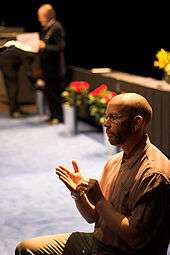Handshape
In sign languages, handshape, or dez, refers to the distinctive configuration of that the hands take as they are used to form words.[1] In Stokoe terminology it is known as the DEZ, an abbreviation of designator. Handshape is one of five components of a sign, along with location (TAB), orientation (ORI), movement (SIG), and facial-body expression. Different sign languages make use of different handshapes.
Handshapes in American Sign Language

A sign language interpreter at a presentation. The two handshapes are the flat (B) hand and the tapered (O or M) hand.
American Sign Language uses 18 handshapes for ordinary signs, plus a few marginal handshapes taken from the American Manual Alphabet for fingerspelling.[2]
Not all handshapes occur with every orientation, movement, or location: there are restrictions. For example, the 5 and F handshapes (the approximate shapes of the hand in fingerspelling 5 and F) only make contact with another part of the body through the tip of the thumb, whereas the K and 8 (AKA Y) handshapes only make contact through the tip of the middle finger, and the X handshape only with the flexed joint of the index finger.
See also
References
- ↑ Tennant and Brown; Richard A. Tennant; Marianne Gluszak Brown (1998). The American Sign Language handshape dictionary. Gallaudet University Press. p. 407. ISBN 1-56368-043-2.
- ↑ Stokoe, Casterline, & Croneberg, 1965. A Dictionary of American Sign Language on Linguistic Principles, Gallaudet
|
|---|
|
|
|
| By region[a] | | Sign languages by region |
|---|
| Oceania | |
|---|
| Asia |
- Bengali
- Chinese
- Philippine
- Indonesia: Indonesian, Kata Kolok (Benkala, Balinese)
- India: Alipur, Bengali Indo-Pakistani, Naga
- Israel: Al-Sayyid Bedouin, Ghardaia, Israeli, Kafr Qasem, Yiddish
- Japan: Amami Oshima, Japanese
- Korean
- Malaysia: Malaysian, Penang, Selangor
- Mongolian
- Nepal: Ghandruk, Jhankot, Jumla, Nepalese
- Persian
- Saudi Arabia: Saudi
- Singapore
- Sri Lankan
- Taiwanese
- Thailand: Ban Khor, Thai
- Vietnamese
|
|---|
| Africa | |
|---|
| Europe | |
|---|
| North America |
- Plains Sign Talk
- Canada: American, Blackfoot, Cree, Ojibwa, Maritime, Quebec, Inuit, Plateau
- Mexico: Chatino, Mayan, Mexican
- United States: American (Black American), Blackfeet, Cree, Cheyenne, Ojibwa, Keresan, Martha's Vineyard, Navajo, Navajo Family, Plateau, Sandy River Valley, Henniker
|
|---|
| South America | |
|---|
| International | |
|---|
|
|---|
|
Language
families[a] | | Sign languages by family |
|---|
| | |
|---|
| |
|
|---|
| | |
|---|
| |
|
|---|
| Chinese Sign |
|
|---|
| | | | |
|
|---|
| Austro-
Hungarian |
|
|---|
| Old Belgian | |
|---|
| | |
|---|
| Dutch | |
|---|
| Italian | |
|---|
| Mexican | |
|---|
|
|---|
| | |
|---|
| | |
|---|
| |
- Bangalore-Madras Sign Language
- Beluchistan Sign Language
- Bombay Sign Language
- Calcutta Sign Language
- Delhi Sign Language
- Nepali
- North West Frontier Province Sign Language
- Punjab-Sindh Sign Language
|
|---|
| | |
|---|
| | |
|---|
| | |
|---|
| | |
|---|
| | |
|---|
| |
- Haiphong
- Hanoi
- Ho Chi Minh City
|
|---|
| | |
|---|
| | |
|---|
| Kentish |
|
|---|
| Other |
|
|---|
| Isolates | |
|---|
|
|---|
|
| ASL | |
|---|
|
Extinct
languages | |
|---|
|
| Linguistics | |
|---|
|
| Fingerspelling | |
|---|
|
| Writing | |
|---|
|
Language
contact |
|
|---|
|
| Media |
- Films (list)
- Television programmes (list)
|
|---|
|
| Persons | |
|---|
|
| Organisations | |
|---|
|
| Miscellaneous | |
|---|
|
^a Sign-language names reflect the region of origin. Natural sign languages are not related to the spoken language used in the same region. For example, French Sign Language originated in France, but is not related to French.
^b Denotes the number (if known) of languages within the family. No further information is given on these languages. |
